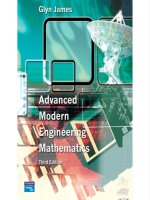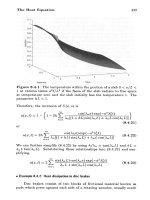essential engineering mathematics
Bạn đang xem bản rút gọn của tài liệu. Xem và tải ngay bản đầy đủ của tài liệu tại đây (3.65 MB, 149 trang )
Michael Batty
Essential Engineering Mathematics
Download free eBooks at bookboon.com
2
Essential Engineering Mathematics
© 2011 Michael Batty & Ventus Publishing ApS
ISBN 978-87-7681-735-0
Download free eBooks at bookboon.com
3
Contents
Essential Engineering Mathematics
Contents
0.
Introduction
8
1.
1.1
1.2
1.2.1
1.2.2
1.2.3
1.2.4
1.3
1.3.1
1.3.2
1.3.3
1.3.4
Preliminaries
Number Systems: The Integers, Rationals and Reals
Working with the Real Numbers
Intervals
Solving Inequalities
Absolute Value
Inequalities Involving Absolute Value
Complex Numbers
Imaginary Numbers
The Complex Number System and its Arithmetic
Solving Polynomial Equations Using Complex Numbers
Geometry of Complex Numbers
10
10
13
13
13
14
16
17
17
18
19
20
2.
2.1
2.2
2.2.1
2.2.2
2.2.3
2.3
Vectors and Matrices
Vectors
Matrices and Determinants
Arithmetic of Matrices
Inverse Matrices and Determinants
The Cross Product
Systems of Linear Equations and Row Reduction
23
23
26
26
27
28
30
e Graduate Programme
for Engineers and Geoscientists
I joined MITAS because
I wanted real responsibili
Maersk.com/Mitas
Real work
International
Internationa
al opportunities
ree work
wo
or placements
Month 16
I was a construction
supervisor in
the North Sea
advising and
helping
foremen
he
solve
problems
s
Download free eBooks at bookboon.com
4
Click on the ad to read more
Contents
Essential Engineering Mathematics
2.3.1
2.3.2
2.3.3
2.4
2.5
Systems of Linear Equations
Row Reduction
Finding the Inverse of a Matrix using Row Reduction
Bases
Eigenvalues and Eigenvectors
30
30
32
34
35
3.
3.1
3.1.1
3.1.2
3.1.3
3.2
3.3
Functions and Limits
Functions
Denition of a Function
Piping Functions Together
Inverse Functions
Limits
Continuity
39
39
39
41
42
43
48
4.
4.1
4.2
4.3
4.4
4.5
4.6
4.7
4.8
4.9
Calculus of One Variable Part 1: Differentiation
Derivatives
The Chain Rule
Some Standard Derivatives
Dierentiating Inverse Functions
Implicit Differentiation
Logarithmic Differentiation
Higher Derivatives
L’Hôpital’s Rule
Taylor Series
51
51
56
58
59
61
63
66
67
69
www.job.oticon.dk
Download free eBooks at bookboon.com
5
Click on the ad to read more
Contents
Essential Engineering Mathematics
5.
5.1
5.2
5.3
5.4
5.5
5.6
5.7
5.8
Calculus of One Variable Part 2: Integration
Summing Series
Integrals
Antiderivatives
Integration by Substitution
Partial Fractions
Integration by Parts
Reduction Formulae
Improper Integrals
79
79
81
85
88
93
98
101
105
6.
6.1
6.2
6.3
6.4
6.5
6.6
Calculus of Many Variables
Surfaces and Partial Derivatives
Scalar Fields
Vector Fields
Jacobians and the Chain Rule
Line Integrals
Surface and Volume Integrals
111
111
113
115
117
119
121
7.
7.1
7.2
Ordinary Differential Equations
First Order Dierential Equations Solvable by Integrating Factor
First Order Separable Differential Equations
123
123
126
7.3
Second Order Linear Differential Equations with Constant Coeficients:
The Homogeneous Case
126
Download free eBooks at bookboon.com
6
Click on the ad to read more
Contents
Essential Engineering Mathematics
7.4
7.5
Second Order Linear Differential Equations with Constant Coeficients:
The Inhomogeneous Case
Initial Value Problems
131
132
8.
8.1
8.2
8.3
Complex Function Theory
Standard Complex Functions
The Cauchy-Riemann Equations
Complex Integrals
134
135
140
142
Index
147
Join the Vestas
Graduate Programme
Experience the Forces of Wind
and kick-start your career
As one of the world leaders in wind power solutions with wind turbine installations in over 65
countries and more than 20,000 employees
globally, Vestas looks to accelerate innovation
through the development of our employees’ skills
and talents. Our goal is to reduce CO2 emissions
dramatically and ensure a sustainable world for
future generations.
Read more about the Vestas Graduate
Programme on vestas.com/jobs.
Application period will open March 1 2012.
Download free eBooks at bookboon.com
7
Click on the ad to read more
Introduction
Essential Engineering Mathematics
Introduction
This book is partly based on lectures I gave at NUI Galway and
Trinity College Dublin between 1998 and 2000. It is by no means a
comprehensive guide to all the mathematics an engineer might encounter during the course of his or her degree. The aim is more to
highlight and explain some areas commonly found difficult, such
as calculus, and to ease the transition from school level to university level mathematics, where sometimes the subject matter is
similar, but the emphasis is usually different. The early sections
on functions and single variable calculus are in this spirit. The
later sections on multivariate calculus, differential equations and
complex functions are more typically found on a first or second
year undergraduate course, depending upon the university. The
necessary linear algebra for multivariate calculus is also outlined.
More advanced topics which have been omitted, but which you will
certainly come across, are partial differential equations, Fourier
transforms and Laplace transforms.
Download free eBooks at bookboon.com
8
Introduction
Essential Engineering Mathematics
This short text aims to be somewhere first to look to refresh
your algebraic techniques and remind you of some of the principles
behind them. I have had to omit many topics and it is unlikely
that it will cover everything in your course. I have tried to make
it as clean and uncomplicated as possible.
Hopefully there are not too many mistakes in it, but if you find
any, have suggestions to improve the book or feel that I have not
covered something which should be included please send an email
to me at
Michael Batty, Durham, 2010.
Download free eBooks at bookboon.com
9
Essential Engineering Mathematics
Chapter 1
Preliminaries
1.1
Number Systems: The Integers, Rationals and Reals
Calculus is a part of the mathematics of the real numbers. You
will probably be used to the idea of real numbers, as numbers on
a “line” and working with graphs of real functions in the product
of two lines, i.e. a plane. To define rigorously what real numbers
are is not a trivial matter. Here we will mention two important
properties:
•
•
Download free eBooks at bookboon.com
10
Preliminaries
Essential Engineering Mathematics
• The reals are ordered. That is, we can always say, for definite,
whether or not one real number is greater than, smaller than,
or equal to another. An example of the properties that the
ordering satisfies is that if x < y and z > 0 then zx < zy
but if x < y and z < 0 then zx > zy. This is important for
solving inequalities.
• A real number is called rational if it can be written as pq for
integers p and q (q = 0). The reals, not the rationals, are the
usual system in which to speak of concepts such as limit and
continuity of functions, and also notions such as derivatives
and integrals. This is because they have a property called
completeness which means that if a sequence of real numbers
Download free eBooks at bookboon.com
11
Preliminaries
Essential Engineering Mathematics
looks like it has a limit (i.e. the distance between successive
terms can always be made to be smaller than a given positive
real number after a certain point) then it does have a limit.
The rationals do not have this property.
The real numbers are denoted by R and the rational numbers are
denoted by Q. We also use the notation N for the set of natural
numbers {1, 2, 3, . . .} and Z for the set of integers {. . . , −2, −1, 0,
√
1, 2, . . .}. For any positive integer n, n is either an integer, or it
is not rational. That is, it is an irrational number.
We will deal with two other number systems of numbers which depend on the reals: vectors of real numbers, and complex numbers.
In Paris or Online
International programs taught by professors and professionals from all over the world
BBA in Global Business
MBA in International Management / International Marketing
DBA in International Business / International Management
MA in International Education
MA in Cross-Cultural Communication
MA in Foreign Languages
Innovative – Practical – Flexible – Affordable
Visit: www.HorizonsUniversity.org
Write:
Call: 01.42.77.20.66
www.HorizonsUniversity.org
Download free eBooks at bookboon.com
12
Click on the ad to read more
Preliminaries
Essential Engineering Mathematics
1.2
Working With the Real Numbers
In this section we will introduce notation that is used throughout
the book and explain some basics of using the real numbers.
1.2.1
Intervals
An interval is a “connected” subset of R and can be bounded i.e.
of the form
• [x, y] = {r in R | x
r
y} (closed),
• (x, y) = {r in R | x < r < y} (open),
• [x, y) = {r in R | x
r < y} (half-open) or
• (x, y] = {r in R | x < r
y} (half-open).
or unbounded i.e. of the form
• (−∞, x] = {r in R | r
x},
• (−∞, x) = {r in R | r < x},
• [x, ∞) = {r in R | r
x},
• (x, ∞) = {r in R | r > x} or
• (−∞, ∞) = R.
1.2.2
Solving Inequalities
When solving inequalities, as opposed to equations, if you
multiply an inequality by a negative number then it reverses
the direction of the inequality.
For example x > 1 becomes −x < −1. People often remember to
do this if they are multiplying by a constant but not when they
multiply by a variable such as x, whose value is not known so it
Download free eBooks at bookboon.com
13
Preliminaries
Essential Engineering Mathematics
could be positive or negative. So it is very important to split your
working into two cases if you have to multiply an inequality by a
variable.
Example 1.2.1 Find all real numbers x such that
12
x+4
2.
If x + 4 < 0 then 12/(x + 4) < 0 < 2. If x + 4 = 0 then 12/(x + 4) is
not defined. Therefore x + 4 > 0, i.e. x > −4. Since x + 4 > 0 we
can multiply the inequality by x+4 without changing the direction
of inequality. This gives 12
2(x + 4) = 2x + 8. Hence 2x
4
which means that x 2. The solution set for the inequality is thus
the interval (−4, 2].
Sketching a graph is a good way to double-check your answer.
The portion of the graph above the dotted horizontal line correspons to the correct range of values.
1.2.3
Absolute Value
Let x be a real number. The absolute value or modulus of x, written
|x|, is the distance between x and 0 on the number line. So it is
always positive. It is defined by
|x| =
x
−x
if x ≥ 0;
if x < 0.
The function f (x) = |x| has the following graph:
Download free eBooks at bookboon.com
14
Preliminaries
Essential Engineering Mathematics
The properties of |x| are as follows, for x, y ∈ R:
• | − x| = |x|
• |xy| = |x||y|
•
x
y
=
|x|
|y|
(y = 0)
Are you remarkable?
Win one of the six full
tuition scholarships for
International MBA or
MSc in Management
Download free eBooks at bookboon.com
15
register
now
rode
www.Nyen
lenge.com
MasterChal
Preliminaries
Essential Engineering Mathematics
1.2.4
Inequalities Involving Absolute Value
If y
0 then the statement |x| < y means −y < x < y, that is,
x ∈ (−y, y). Consider the following graph to see why this is true.
Similarly
• |x|
y means −y
x
y.
• |x| > y means x > y or x < −y.
• |x|
y means x
y or x
−y.
• |x| = y means x = y or x = −y (it is usual to write x = ±y).
Example 1.2.2
1. Find all x ∈ R for which |x − 1|
3.
We have |x − 1| 3 if and only if −3 x − 1 3. Adding 1,
−2 x 4 and the solution set is the interval [−2, 4]. We
can check this by drawing a graph.
2. Find all real numbers x ∈ R for which |x + 2|
2.
If |x + 2| 2 then either x + 2 −2 or x + 2 2, i.e. x −4
or x 0. So x satisfies the inequality if and only if it lies in
the set (−∞, −4] ∪ [0, ∞).
Download free eBooks at bookboon.com
16
Preliminaries
Essential Engineering Mathematics
3. Find all x ∈ R for which |x2 − 4| > 3.
x2 − 4 > 3 or x√2 − 4 <
Suppose that |x2 − 4| > 3. Then either √
−3. If x2 −√4 > 3√ then either x > 7 or x < − 7, i.e.
x ∈ (−∞, − 7) ∪ ( 7, ∞). If x2 − 4 < −3 then x2 < 1 which
implies that x ∈ (−1, 1). Thus the complete solution set to
the inequality is
√
√
(−∞, − 7) ∪ (−1, 1) ∪ ( 7, ∞),
1.3
Complex Numbers
1.3.1
Imaginary Numbers
There is only space here to give a brief overview of the complex
numbers. It is the number system formed when we want to include all square roots of the number system inside the system itself. Remarkably we can do this by adding a single extra number i
(standing for imaginary) such that i2 = −1. Of course there is no
real number with this property as squaring a real number always
results in something greater than or equal to zero.
Let y < 0. Then for some m > 0,
√
√
√
√
√
y = −m = −1 · m = i m
A number of the form yi for y ∈ R is called a purely imaginary
number. So square roots of real numbers are always real or purely
imaginary.
Download free eBooks at bookboon.com
17
Preliminaries
Essential Engineering Mathematics
1.3.2
The Complex Number System and its Arithmetic
What if we consider roots of purely imaginary numbers? Note that
(1 + i)2 = 12 + 2i + i2 = 1 + 2i − 1 = 2i
So the expression on the left hand side, a sum of a real number
and a purely imaginary number, can be thought of as the square
root of a purely imaginary number.
A complex number is an expression of the form x+yi where x
amd y are real numbers and i2 = −1. The complex number
system is denoted by C.
Do you have drive,
initiative and ambition?
Engage in extra-curricular activities such as case competitions, sports, etc. – make new friends among cbs’ 19,000
students from more than 80 countries.
See how we
work on cbs.dk
Download free eBooks at bookboon.com
18
Click on the ad to read more
Preliminaries
Essential Engineering Mathematics
To add, subtract and multiply complex numbers, we use ordinary rules of arithmetic and algebra and whenever it appears, we
substitute i2 with −1. For example
(3 − 2i) + (5 + i) = 8 − i
(6 + i) − (6 − 2i) = 3i
(2 − i)(3 + 2i) = 6 − 3i + 4i − 2i2 = 8 + i
To divide a complex number by another complex number first multiply the numerator and denominator by what is called the complex
conjugate of the complex number.
If z = a + ib then the complex conjugate of z, written z, is
a − ib.
The properties of the complex conjugate are as follows.
• zz = a2 + b2 , which is real.
• z + z = 2a, also real.
• z − z = 2bi, which is purely imaginary.
For the purposes of division the first of these properties is the most
important. For example
1−i 2−i
·
2+i 2−i
=
=
=
1.3.3
22
1
(1 − i)(2 − i)
+ 12
1
(2 − 2i − i − 1)
5
1 3
− i
5 5
Solving Polynomial Equations Using Complex
Numbers
Remember that for quadratic equations
2
ax + bx + c = 0 implies x =
−b ±
√
b2 − 4ac
.
2a
Download free eBooks at bookboon.com
19
Preliminaries
Essential Engineering Mathematics
If the discriminant b2 − 4ac < 0 then there are no real roots. But
2
in this case we in fact have
√ two complex roots. For example x +
1
4x + 5 = 0 gives −2 ± 2 −4 = −2 ± i.
It can be shown that the roots of such a quadratic equation, with
negative discriminant, always occur in conjugate pairs, i.e. they
are conjugates of each other. We should also mention (but not
prove, as it is difficult) the following
Fundamental Theorem of Algebra: Given a polynomial
equation such as
xn + an−1 xn−1 + · · · + a1 x + a0 ,
the equation has at most n roots, all of which are in C.
So by introducing a single quantity, the imaginary square root of
−1, we get a lot in return - all polynomial equations can now be
solved.
1.3.4
Geometry of Complex Numbers
A complex number z = x + iy can be plotted as (x, y) in the plane.
This plane is called the Argand diagram or the complex plane (c.f.
the real line). With this geometric interpretation,
• z is the reflection of z in the x-axis.
• |z| = x2 + y 2 is the modulus of z, the length of the
line segment from the origin to z.
• for z = 0, the argument of z, written arg z, is the
angle the same line segment makes with the real axis,
measured anti-clockwise.
So the modulus generalises the idea of the absolute value of a real
number, and argument generalises the idea of the sign of a real
number, in the sense that a complex number is a real number
x > 0 if and only if it has argument 0, and it is a real number
Download free eBooks at bookboon.com
20
Preliminaries
Essential Engineering Mathematics
x < 0 if and only if it has argument π2 . For example, |i| = 1 and
arg i = π2 . We can write any complex number in polar form, i.e. as
z = r(cos θ + i sin θ) where r is |z| and θ is arg z. In general,
• arg zw = arg z + arg w
• |zw| = |z||w|
If x = 0 then arg(z) = tan−1 ( xy ). But it is important not to just
put the relevant values into your calculator and work out inverse
tangent because it will give you the wrong answer half of the time.
You need to draw a picture and work out which quadrant of the
complex plane the complex number is in. For example,
1+i=
but
−1 − i =
√
√
2 cos
2 cos
π
π
+ i sin
4
4
−3π
4
+ i sin
−3π
4
.
Download free eBooks at bookboon.com
21
Click on the ad to read more
Preliminaries
Essential Engineering Mathematics
The following is used to find roots (not just square ones) of
complex numbers:
De Moivre’s Theorem: (cos θ + i sin θ)n = cos nθ + i sin nθ
For example, to calculate the fifth roots of unity (one), we write
z = r(cos θ + i sin θ) and seek to solve the equation
z 5 = r5 (cos θ + i sin θ)5 = 1
So r = 1, because r > 0 is real, and by de Moivre’s theorem we
have
cos 5θ + i sin 5θ = 1.
Importantly, 5θ = arg1 does not just mean 5θ = 0 but that 5θ =
2πm for any integer m. This gives θ = 2πm
5 and m = 0, 1, 2, 3 and
4 all give unique values. So there are five fifth roots of 1:
• z1 = cos 0 + i sin 0 = 1
2π
• z2 = cos 2π
5 + i sin 5
4π
• z3 = cos 4π
5 + i sin 5
−4π
• z4 = cos −4π
5 + i sin 5
2π
• z5 = cos 2π
5 + i sin 5
We can plot them on an Argand diagram as follows: As an exercise,
try to calculate the sixth and seventh roots of 1, and the fifth roots
of −1.
Download free eBooks at bookboon.com
22
Vectors and Matrices
Essential Engineering Mathematics
Chapter 2
Vectors and Matrices
Vectors and matrices can be thought of as generalisations of numbers. They have their own rules of arithmetic, like numbers, and a
number can be thought of as a vector of dimension 1 or a 1 by 1
matrix.
2.1
Vectors
Geometrically vectors are something with direction as well as magnitude. More abstractly they are lists of real numbers. In different
situations it helps to think of them as one or the other, or both. For
calculations treat them as lists of numbers. But it sometimes can
help intuition to think of them as geometric objects. The vector
x=
a
b
has magniutude, more commonly called modulus,
|x| =
a2 + b2 .
We will illustrate vector operations using vectors of length two or
three. Vectors can have any number of entries but the operations
on them are similar. Except for the cross product which is only
defined for vectors of length three.
Download free eBooks at bookboon.com
23
Vectors and Matrices
Essential Engineering Mathematics
Each number in the list is called a component. Vectors can be
added and subtracted by adding and subtracting component-wise,
i.e.
a
b
c
d
+
=
a+c
b+d
Similarly vectors can be multiplied by a “scalar”, i.e. a real
number, as follows.
λ
a
b
=
λa
λb
Develop the tools we need for Life Science
Masters Degree in Bioinformatics
Bioinformatics is the
exciting field where biology,
computer science, and
mathematics meet.
We solve problems from
biology and medicine using
methods and tools from
computer science and
mathematics.
Read more about this and our other international masters degree programmes at www.uu.se/master
Download free eBooks at bookboon.com
24
Click on the ad to read more









